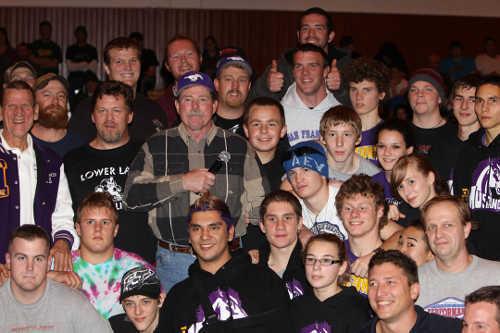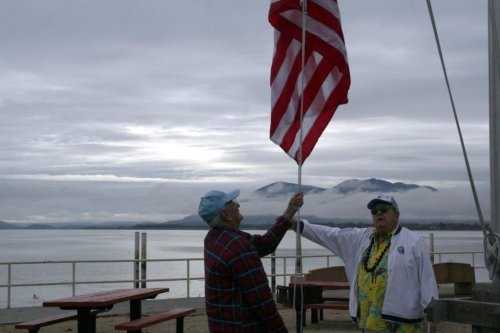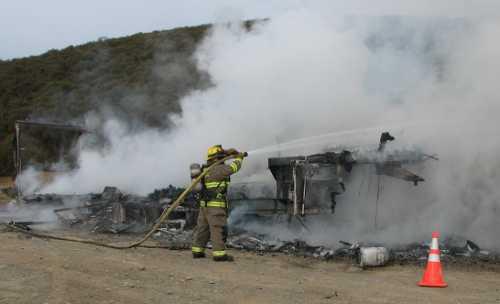Pearl Harbor survivors and sweethearts share a smile. From left, Clarence “Bud” Boner, Walter Urmann, Bill Slater, Alice Darrow, Vanya Leighton, Henry Anderson and Jim Harris. Photo by Janeane Bogner.
Harris moved onto the admiral's barge, which went around the hospital ship USS Solace which had anchored off the Dobbin.
He watched as, just after 8 a.m., the USS Vestal and the USS Arizona – which had been moored together – were hit, and the Vestal's captain was blown off the ship's bridge. The captain survived, and as the admiral's barge started for him, Harris said the captain waved them toward the Arizona.
“We started toward the Arizona to pick up survivors, and that's when she exploded,” said Harris.
He said that by the time they got to the Arizona, “There were no survivors to pick up as far as we could find.”
Harris and his fellow sailors would hurry to try to pull fellow sailors from the oil-coated waters. In one case, he recounted trying to pull a man up and having the man's skin come off in his hands.
Later, he would be assigned to a work team sent to the USS Arizona to identify bodies, he said in a recorded interview late last year with Kelseyville resident Steve Davis, the county's retired California Highway Patrol commander.
In one place on the Arizona, Harris recounted that the work team found a human humerus bone – the long bone of the upper arm – driven through eight-inch armor in the ship.
They also gained entry to a boiler room where they found 21 bodies of reservists who had assembled on Dec. 7 for training, he said.
“They were trapped,” Harris said.
The men, who didn't know how to get out, kept a log for 17 days, before they starved to death, in what Harris said was one of the attack's untold stories.
Surviving Pearl Harbor would be only one of the horrifying chapters of the war Harris would live through.
After Pearl Harbor Harris found himself traveling farther into the Pacific Theater, where he was assigned to the destroyer USS Stewart.
During the February 1942 Battle of Badung Strait he was blown off the Stewart's bridge, but rescued by a Dutch PBY seaplane, which transported him to a hospital in nearby Surabaya, Indonesia.
Harris said in a 2009 interview that he and other patients were warned to leave the hospital because of the Japanese, invading from the north. Harris and his fellow patients secured a launch and traveled by night along the shore until they happened upon an American destroyer, the USS John D Ford, sitting camouflaged in a river.
He said he later found out that those who stayed behind at the hospital – patients too ill to travel and staff who stayed to care for them – were slaughtered, some beheaded by the Japanese.
Moving into the European Theater
Within a few years, Harris found himself on the other side of the world, in the European Theater.
By age 19, he was assigned to the destroyer USS McCook, which saw duty in the Mediterranean before heading off to England to prepare for the Normandy invasion.
In April 1944 the then-second class petty officer and sonar man was aboard the USS McCook as part of Operation Tiger, a preparation exercise for D-Day held at Slapton Sands, off the coast of Devon, England.
“This rehearsal was what you might call chaos,” Harris said at the county's June 2009 D-Day commemoration.
Hundreds of men died after German submarines showed up and sank three troop ships. Harris said the incident was kept so quiet that the men who died there were counted as casualties at D-Day.
Two months later, on June 6, 1944, the McCook and Harris would be at Omaha Beach as the Allies sought to invade France and break Germany's stranglehold on the continent.
Harris said the McCook's captain saw Germans firing from the cliffs above onto the Allied forces on the beaches, and the admiral gave the command to go after them.
He said the 345-foot McCook was steered into the breakers, trying to avoid mines while attempting to get close enough to shoot at the cliffs above. With each wave, the ship had to be thrust into reverse to avoid the mines or running aground.
The McCook shot an estimated 1,000 rounds into the cliffs at Pointe du Hoc, hitting “Tiger” tanks and German soldiers who were firing down on the landing Allied Forces, according to historical accounts.
Harris said of D-Day, “That was the longest day I ever lived.”
As a member of the McCook crew, Harris would take part in invading southern France as part of Operation Anvil.
By the end of 1944, Harris was sent home to the US because of an injury suffered earlier in the war in the South Pacific.

Pearl Harbor and D-Day survivor Jim Harris receives the French Liberation Medal from Michelle Price on Monday, August 24, 2009, in High Valley. Photo by Ginny Craven.
After the war
After the Navy, Harris went to work in the Bay Area as an agent for American National Life Insurance Co. On April 6, 1950, he and the love of his life, Helen, were married.
The Harrises raised a daughter, Diane, and eventually they made their way to Lake County in 1967.
Their daughter died in 2001, but they moved forward, Jim Harris staying acting in veterans groups and keeping the memory alive of what he and other men like him had survived in the war.
That included helping inspire the Pearl Harbor Survivors’ Memorial Mast at Library Park in Lakeport, which his brother, Leon Harris, designed, and which was taken on as a project by the Lakeport Rotary.
At a Pearl Harbor Survivors Association breakfast in August 2009, Bogner arranged for Harris to receive a surprise in the form of a long-desired token of his service – the French Liberation Medal, which the French government issued to commemorate its liberation from the Nazis in World War II.
Harris called the medal “the most wonderful surprise I've had in many, many years.”
Recently, Brown took a contingent of Kelseyville High School wrestlers, who he coaches, to meet Harris, because he said he wanted them to meet a real American hero.

Jim and Helen Harris of Lucerne, Calif., celebrated 60 years as husband and wife at an anniversary party in Lucerne on April 6, 2010. Photo by Ginny Craven.
Bogner had seen Harris about a week before he died, taking him an old postcard of the USS Dobbin that he had purchased for Harris on eBay.
Janeane Bogner spoke with Harris on the phone the day before his death. Harris seemed to be doing well, Ronnie Bogner said, noting that no one expected Harris would go so soon.
Harris' death follows by two months that of Clearlake Oaks resident Chuck Bower, who was at the US Sub Base at Pearl Harbor. Bower died Nov. 12.
With the passing of Bower and Harris, there are now five Pearl Harbor survivors remaining in Lake County – Clarence “Bud” Boner, Floyd Eddy, Bill Slater, Walter Urmann and Henry Anderson, and “sweethearts” – or widows – Alice Darrow, Vanya Leighton, Lynn Poehler and Charlotte Bower, and now Helen Harris.
Bogner said Pearl Harbor survivors from Lake County and beyond are planning to attend the Thursday memorial.
In a December 2007 interview Harris said of his experiences at Pearl Harbor, “Everybody came away from there with a different attitude. Only time has made a difference to us.”
For additional stories on Jim Harris, please see the following:
Recalling the 'Day of Days': Vets gather for D-Day ceremony
Veterans remember attack on Pearl Harbor
Pearl Harbor survivors talk of life after the attack
Solemn ceremony honors Pearl Harbor's living and lost
Solemn commemoration marks 65th D-Day anniversary
Pearl Harbor and D-Day veteran receives special token of service
Survivors, community members gather to remember Pearl Harbor attack
Harrises celebrate 60 years together
County's annual Veterans Day ceremony honors service of the past, present and future
Solemn Dec. 7 commemoration acknowledges debt of gratitude
E-mail Elizabeth Larson at This email address is being protected from spambots. You need JavaScript enabled to view it. . Follow Lake County News on Twitter at http://twitter.com/LakeCoNews , on Facebook at http://www.facebook.com/pages/Lake-County-News/143156775604?ref=mf and on YouTube at http://www.youtube.com/user/LakeCoNews .

Members of the Kelseyville High School wrestling team visited with Jim Harris in Lucerne, Calif., in late November 2010. Photo by Rob Brown.


 How to resolve AdBlock issue?
How to resolve AdBlock issue? 


















